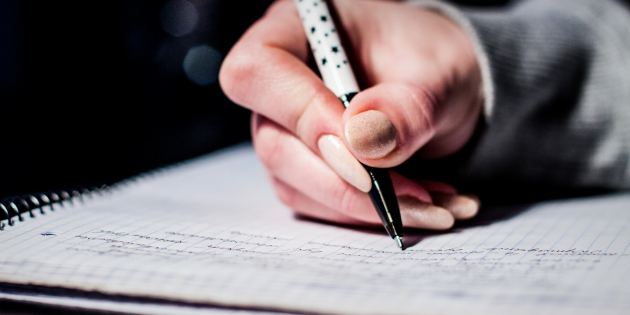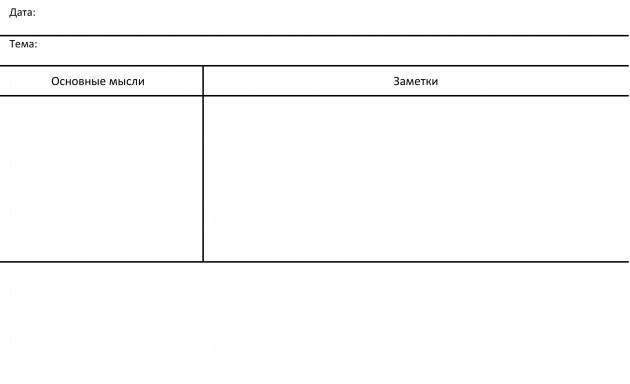510
How to record a lecture the Cornell method
In school we were all taught to write from dictation. But it has no relationship to the notes. Cornell method restore order in a chaotic student records and allows you to easily prepare for exams. By the way, this method will be useful to you at work during meetings.

Notes made by hand, much better notes on the laptop. When you write on paper, you are more focused and attentive. However, notes in notebook often turn into a random collection of squiggles, among which a couple of weeks it is impossible to find the necessary information. You will rescue method Cornell.
The basics the Cornell methodTo organize your notes the Cornell method, you can use any notebook. On the worksheet, draw a thick horizontal line 5 cm above the bottom edge. Then add the heavy vertical line at a distance of 5-7 cm from the left edge. The end result is a sheet divided into three sections:
Right for notes.Left for the main thoughts and questions.The lower part of the summary.
Razlikuje Notepad yourself, download the worksheet in PDF format at the end of this article or find at a stationery store notebook for taking notes the Cornell method.
Examples of using the method the CornellMethod the Cornell to record lectures at the Top of the sheet write the date and title of lecture. In the column "Notes" outline the key points. No need to record everything. The main rule of the Cornell method: less is better. Record questions that arise during lectures, and celebrate the moments in which you later will understand more.
The left-hand column you fill in, when I re-read the recorded lecture. Do not postpone this task, it is better to analyze on the same day or at least for the next while in my head fresh memories. Most likely, some of the phrases you wrote is unclear, just adjust them.
So, in the left column should get only the main points learned from the notes, and the answers to the questions you asked yourself while listening to the lecturer.
Summary at the bottom of the list — the main idea of the lecture, a summary of what you heard, recorded your words. If you can write a summary, then the material you have learned.
Not utrambovyvaya a lecture on one page, but divide it into logical parts. If you fail to move the new piece on the next page, tchernia his bold line. It is possible to summarize the lecture as a whole or its individual chapters.
Notes taken with the Cornell method, easy to prepare for exams. Because the most important thing is to understand the material. And you will learn it during the processing of the lectures. To refresh knowledge in memory, just read your short entry. Try to arrange yourself a test: close the right half of the sheet with notes to explain each thesis of the lecture from the left column.
Method Cornell at the meeting of the Right graph ("Notes") of notes made during the meeting or conversation.
The left graph ("Basic thoughts") — the main idea of the meeting that you are recording after analyzing their records.
Your records will almost certainly be chaotic. It's not a lecture. The interviewee may stray, leaping from topic to topic, idea to lose. Meeting may even seem useless until you analyze it and highlight the main theses.
Summary — summary of the meeting.
Method Cornell to prepare for the performances Left of the graph ("Basic ideas") — abstract of the speech.
The right graph ("Notes") — the disclosure of abstracts (briefly). Mark the points that should be definitely mentioned.
Summary — the main idea of the report.
Manually writing the thesis, you again will think about them, remember. And before the show will be able to repeat the report.
Cornell method for planning weeks Left of the graph ("Basic ideas") — plans for the week.
The right graph ("Notes") — break plans into small business.
Summary — the main goal of the week.
The Cornell method will get you out of the chaos of jumbled records. A clear structure will find not only your notes and your thoughts! published
P. S. And remember, only by changing their consumption — together we change the world! ©
Join us in Facebook and in Vkontakte, and we're Classmates
Source: lifehacker.ru/2015/09/09/metod-kornella/

Notes made by hand, much better notes on the laptop. When you write on paper, you are more focused and attentive. However, notes in notebook often turn into a random collection of squiggles, among which a couple of weeks it is impossible to find the necessary information. You will rescue method Cornell.
The basics the Cornell methodTo organize your notes the Cornell method, you can use any notebook. On the worksheet, draw a thick horizontal line 5 cm above the bottom edge. Then add the heavy vertical line at a distance of 5-7 cm from the left edge. The end result is a sheet divided into three sections:
Right for notes.Left for the main thoughts and questions.The lower part of the summary.

Razlikuje Notepad yourself, download the worksheet in PDF format at the end of this article or find at a stationery store notebook for taking notes the Cornell method.
Examples of using the method the CornellMethod the Cornell to record lectures at the Top of the sheet write the date and title of lecture. In the column "Notes" outline the key points. No need to record everything. The main rule of the Cornell method: less is better. Record questions that arise during lectures, and celebrate the moments in which you later will understand more.
The left-hand column you fill in, when I re-read the recorded lecture. Do not postpone this task, it is better to analyze on the same day or at least for the next while in my head fresh memories. Most likely, some of the phrases you wrote is unclear, just adjust them.
So, in the left column should get only the main points learned from the notes, and the answers to the questions you asked yourself while listening to the lecturer.
Summary at the bottom of the list — the main idea of the lecture, a summary of what you heard, recorded your words. If you can write a summary, then the material you have learned.
Not utrambovyvaya a lecture on one page, but divide it into logical parts. If you fail to move the new piece on the next page, tchernia his bold line. It is possible to summarize the lecture as a whole or its individual chapters.
Notes taken with the Cornell method, easy to prepare for exams. Because the most important thing is to understand the material. And you will learn it during the processing of the lectures. To refresh knowledge in memory, just read your short entry. Try to arrange yourself a test: close the right half of the sheet with notes to explain each thesis of the lecture from the left column.
Method Cornell at the meeting of the Right graph ("Notes") of notes made during the meeting or conversation.
The left graph ("Basic thoughts") — the main idea of the meeting that you are recording after analyzing their records.
Your records will almost certainly be chaotic. It's not a lecture. The interviewee may stray, leaping from topic to topic, idea to lose. Meeting may even seem useless until you analyze it and highlight the main theses.
Summary — summary of the meeting.
Method Cornell to prepare for the performances Left of the graph ("Basic ideas") — abstract of the speech.
The right graph ("Notes") — the disclosure of abstracts (briefly). Mark the points that should be definitely mentioned.
Summary — the main idea of the report.
Manually writing the thesis, you again will think about them, remember. And before the show will be able to repeat the report.
Cornell method for planning weeks Left of the graph ("Basic ideas") — plans for the week.
The right graph ("Notes") — break plans into small business.
Summary — the main goal of the week.
The Cornell method will get you out of the chaos of jumbled records. A clear structure will find not only your notes and your thoughts! published
P. S. And remember, only by changing their consumption — together we change the world! ©
Join us in Facebook and in Vkontakte, and we're Classmates
Source: lifehacker.ru/2015/09/09/metod-kornella/
This girl is missing one arm, but strength of spirit enough for seven people.
Mercedes-Benz will release an electric car with a range of 500 kilometers























